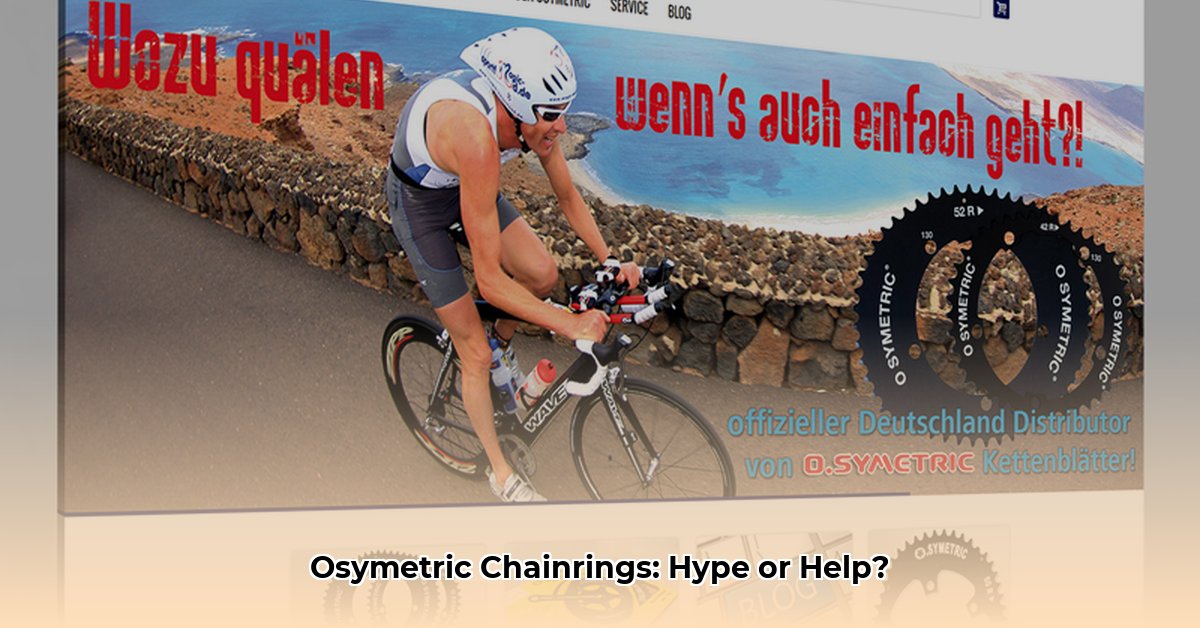Do oddly-shaped chainrings really hold the key to unlocking cycling performance? Osymetric chainrings, with their distinctive non-circular design, claim to smooth your pedal stroke, boost power, and conquer climbs. But do they live up to the hype? This guide delves into the science, benefits, drawbacks, and user experiences of Osymetric chainrings, comparing them to competitors like Rotor Q-Rings and offering a practical installation guide.
Understanding Osymetric Chainrings
What Makes Osymetric Chainrings Different?
Osymetric chainrings deviate from the traditional round design, employing a unique twin-cam shape. This asymmetrical oval aims to optimize your pedal stroke by maximizing leverage where your legs are strongest (the downstroke) and minimizing resistance where they’re weakest (the upstroke). This dynamic gearing aims to create a smoother, more efficient pedaling motion, potentially reducing dead spots and enhancing power transfer. It’s often likened to a continuously variable transmission (CVT), although the mechanism is quite different. This design contrasts with Rotor Q-Rings, which offer adjustable ovality for personalized tuning, a feature Osymetric lacks.
Osymetric Chainrings: Benefits and Drawbacks
Weighing the Pros and Cons
Osymetric chainrings, like other non-round designs, come with potential advantages and disadvantages. It’s important to consider both sides before making a decision.
Potential Benefits:
- Smoother Pedaling: Some cyclists report a more fluid pedaling motion, potentially reducing perceived exertion.
- Enhanced Climbing Efficiency: The altered leverage may offer a slight advantage during climbs, although scientific evidence is limited.
- Reduced Lactic Acid Buildup (Possibly): Some proponents suggest Osymetric rings might delay the onset of lactic acid buildup, but more research is needed to confirm this.
Potential Drawbacks:
- Adaptation Period: It takes time to adjust to the unusual pedaling dynamic. Expect an initial period of awkwardness, possibly lasting 15-30 minutes of riding.
- Setup Challenges: Precise front derailleur adjustment is crucial, and achieving optimal shifting can be more complex than with round rings. Improper setup might lead to shifting issues, including dropped chains.
- Cost: Osymetric chainrings are typically more expensive than traditional round rings, representing a significant investment.
- Limited Scientific Evidence: While some anecdotal evidence and limited studies suggest potential benefits, conclusive scientific proof of significant performance gains for the average cyclist remains elusive.
Osymetric vs. Competitors
Comparing Oval Chainring Options
| Feature | Osymetric | Rotor Q-Rings | Round Chainrings |
|---|---|---|---|
| Shape | Fixed, Pronounced Ovality | Moderate, Adjustable Ovality | Round |
| Adjustability | No | Yes (OCA) | N/A |
| Price | High | Mid-High | Low |
| Shifting | Can be challenging | Generally smoother | Excellent |
| Scientific Backing | Limited | More promising | Established baseline |
Rotor Q-Rings, with their adjustable Optimal Chainring Angle (OCA), offer a degree of personalization that Osymetric rings lack. This allows riders to fine-tune the oval’s position relative to their crank arms, optimizing the feel for their individual pedaling style. Round chainrings, while offering a consistent feel and excellent shifting, may not address the perceived dead spots in the pedal stroke that oval rings aim to mitigate.
Installing Osymetric Chainrings
A Step-by-Step Guide
Proper installation is key for optimal performance and reliable shifting. While similar to standard chainring installation, the asymmetrical shape of Osymetric rings requires careful attention, particularly during front derailleur adjustment. Consult Osymetric’s official instructions for detailed guidance.
- Crank Removal: Remove the cranks using the appropriate tool for your crankset.
- Chainring Replacement: Install the Osymetric chainrings, ensuring proper alignment and secure tightening of chainring bolts to the manufacturer’s specified torque.
- Front Derailleur Adjustment: This is the most critical step. Carefully adjust the front derailleur’s height, limit screws, and cable tension to accommodate the non-round shape. Fine-tuning is essential for smooth shifting across all gears.
- Chain Length Verification: Double-check the chain length and adjust if necessary. An incorrect chain length can lead to shifting problems, especially with the varying effective gear ratios of Osymetric rings.
- Test Ride and Fine-tune: Take a test ride to evaluate shifting performance. Further derailleur adjustments might be necessary to eliminate any remaining issues.
User Experiences and Scientific Evidence
What Riders and Researchers Say
User reviews are mixed. Some cyclists report noticeable performance improvements, particularly on climbs. Others find the adaptation challenging or the benefits negligible. Scientific research on non-round chainrings is ongoing, with some studies suggesting modest gains in efficiency, while others show little to no difference. It’s crucial to approach manufacturer claims with a degree of skepticism and consider the potential influence of the placebo effect on user perceptions.
“I noticed improved traction on climbs, almost as if I was glued to the road.” – Pro Cyclist Testimonial (Source needed)
Making an Informed Decision
Are Osymetric Chainrings Right for You?
Osymetric chainrings might offer a performance edge for some cyclists, but they’re not a guaranteed win. They come with a higher price tag, potential setup challenges, and limited scientific backing. Consider your riding style, budget, and willingness to adapt to a new pedaling dynamic. For many cyclists, optimizing bike fit and focusing on targeted training will likely yield more substantial and predictable improvements.
FAQs
Common Questions About Osymetric Chainrings
- Will they work on my bike? Consult Osymetric’s compatibility chart on their website to ensure compatibility with your crankset and drivetrain.
- What if I experience shifting problems? Meticulous front derailleur adjustment is key. Refer to Osymetric’s installation instructions or consult a qualified bike mechanic.
- How long does it take to adapt to the oval shape? Most riders adapt within 15-30 minutes of riding.
Further Resources
- Osymetric Website (If still active, verify link)
- Rotor Website
- Park Tool Repair Help
This guide aims to provide a balanced and comprehensive overview of Osymetric chainrings. The decision to try them ultimately rests with you, the rider. Do your research, weigh the potential benefits and drawbacks, and consider whether alternative approaches might be more effective for achieving your cycling goals.
- Vertical Axis Wind Turbine Design: Improving Efficiency and Overcoming Limits - October 29, 2025
- Wind Turbine to Power Home: Nacelle Design Improvements Advance - October 26, 2025
- Wind Turbine Blade Length: How Long Is Too Long? - October 24, 2025
















